Latest News
Measuring exposure at risk key to manage climate events: RBI Dy Governor

New Delhi: Stating that the consequences, intensity, severity, and frequency of climate events were hard to measure and difficult to predict, the Reserve Bank of India (RBI) Deputy Governor M Rajeshwar Rao noted that the first step for banks and other regulated entities must take is to measure the amount of exposure at risk.
“The impact of these events (climate events) on banks and financial institutions is even more difficult to quantify. Therefore, the first step in managing the risks to which banks and other regulated entities are exposed from climate events is to measure the amount of exposure at risk,” Rao said at a panel discussion on ‘Climate Implications for Central Banking’ organised by the IMF and Center for Social and Economic Forum last week. The excerpts of the speech were made available by the RBI on Tuesday.
In his address, he mostly focused on the role of central banks in managing the outcomes from climate change. He also underlined that a successful transition to a sustainable future will require a multi-faceted approach that involves governments, private sector entities, financial institutions, civil society organizations and the public.
“The data related to exposure of firms, banks and financial institutions to climate events is crucial for planning the transition,” Rao said, adding it would only be possible if the firms adequately and transparently disclose the carbon intensity of their operations.
Besides measuring exposure at risk, he said the next step is to ensure the availability of data and identification of vulnerabilities.
Noting that central banks across the globe are encouraging banks and other lenders to identify such vulnerabilities, the RBI deputy governor said it is also planning on issuing guidance to banks on the stress testing for climate vulnerability of their credit portfolio.
Financial markets the world over are also increasingly beginning to integrate climate risks and opportunities into investment decision-making.
“The number of ESG-focused funds is increasing globally. Institutional investors are expecting their investee companies to make detailed climate-related financial disclosures, pursue net-zero goals, declare transition plans and report progress,” Rao said.
Further, speaking about RBI’s initiatives, he said the central has been taking various policy measures to promote and support green finance initiatives.
He cited how finance to renewable energy projects have been included as a part of the Priority Sector Lending (PSL) portfolio of banks.
Earlier this year, the RBI supported the Centre in successfully issuing sovereign green bonds (SGrBs). The proceeds of the SGrBs were intended to be deployed in public sector projects which will help in reducing the carbon intensity of the economy.
A sovereign green bond is a debt investment instrument issued by the central or state government to borrow money from investors with the commitment that the mobilized fund will be spent on climate or ecosystem-related activities. This phenomenon began in 2016 with the Poland government issuing its first sovereign green bond.






.jpg)
.jpg)
.jpg)
.jpg)

.jpg)


.png)





.png)
